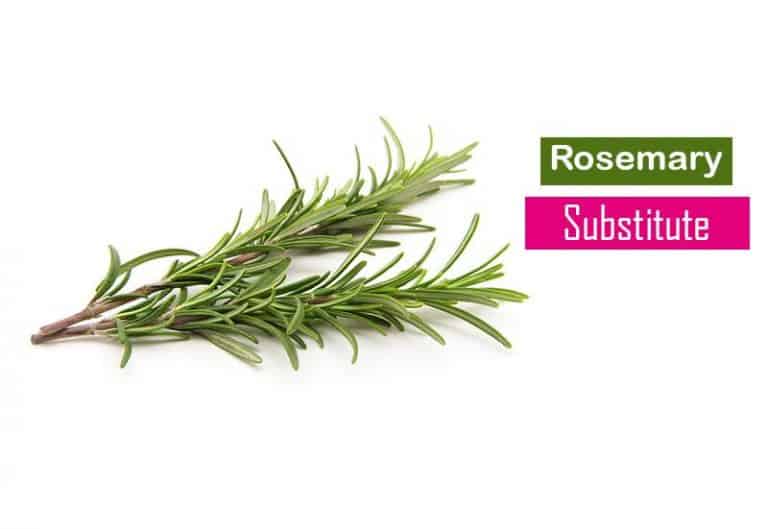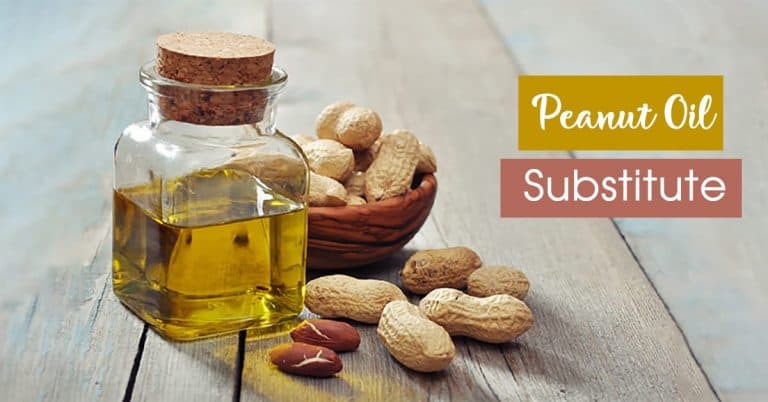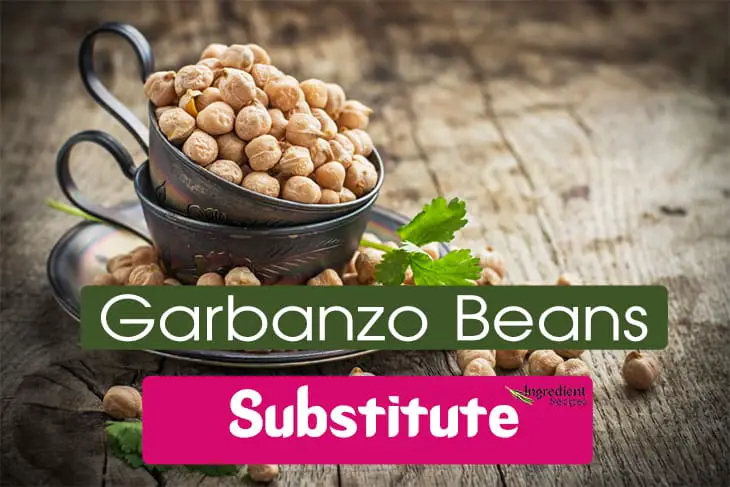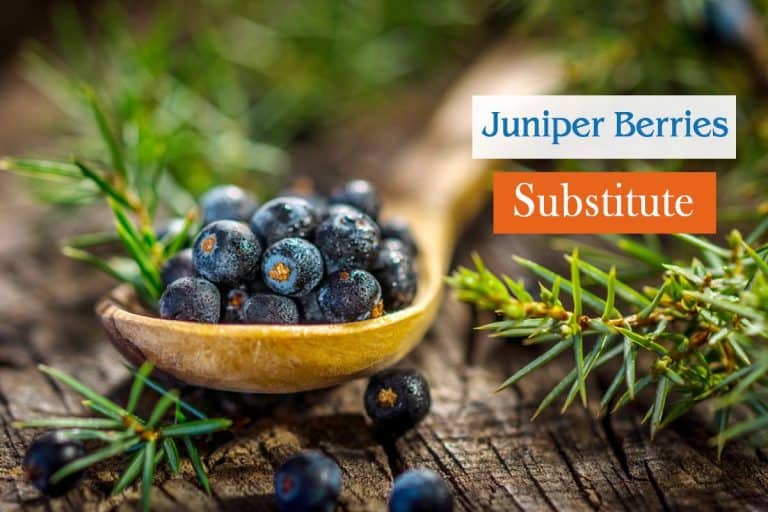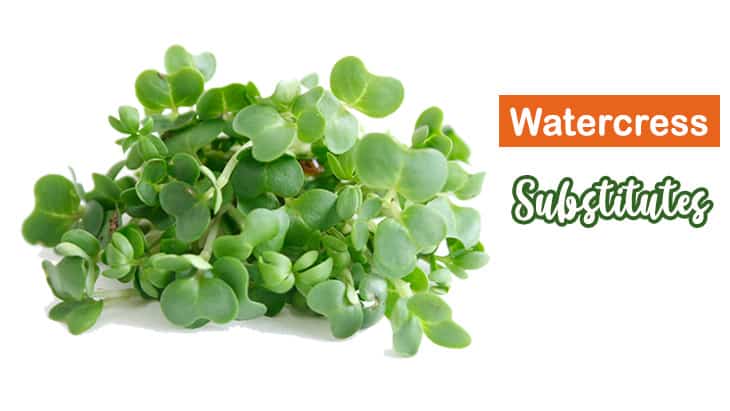
Why do people keep finding substitutes for watercress?
Watercress is no longer a new ingredient in cooking, appearing in many savory dishes, from salads to soups. Chances are, your local markets may only have it during the months of April until October before it turns bitter. But what if you crave it in the winter?
In this case, picking up an ingredient comparable to this vegetable is necessary. In this article, we will suggest 14 proper alternatives for watercress that you can try.
Top 14 Substitutes For Watercress
Now, let’s find out what kinds of vegetables can replace watercress well.
1. Arugula

Arugula, also called Rocker, turns out the best candidate on this list since it delivers a spicy flavor comparable to watercress. However, it comes with a less bitter taste and a herby aroma. Those who are not into watercress will find this one more taste-friendly.
When it comes to arugula recipes, salad might be the first choice. But today, we will blow your mind with this suggestion: the Arugula artichoke and prosciutto pizza.
The peppery but not bitter flavor of arugula paired with the sweet artichoke will neutralize the meaty prosciutto. This mixture can make you eat a whole pizza without aversion.
Arugula is rich in calcium, supporting blood clotting and strengthening your bones. Potassium in this vegetable also helps lower blood pressure by alleviating tension in vessel walls.
Arugula is prone to burn, so you need a shorter cooking time. It is best served after shrinking about 50%.
2. Radish Sprouts
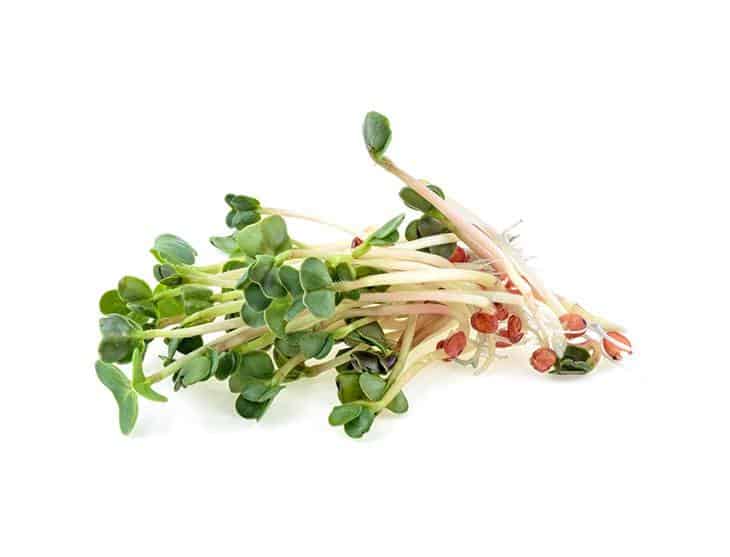
Radish sprouts, coming from the same family, are brothers of watercress. You can easily find out that they are in the same shape and offer a similar spiciness. But these sprouts taste a little more pungent. It is hard to buy them from markets, yet you can easily grow them from radish seeds.
These greens appear in most salad dishes. If you are fed up with them, try Smoked salmon wrap with radish sprouts. The pungency will eliminate the fishy flavor and glorify the sweetness of salmon.
These little sprouts are fully packed with chlorophyll and crucial amino acids, contributing to the cancer-fighting process. Even better, the included folate helps form red blood cells, essential in early pregnancy.
Since radish sprouts are so vulnerable, it is better to eat them raw. Otherwise, only cook them for 20-30 seconds.
3. Nasturtium Leaves
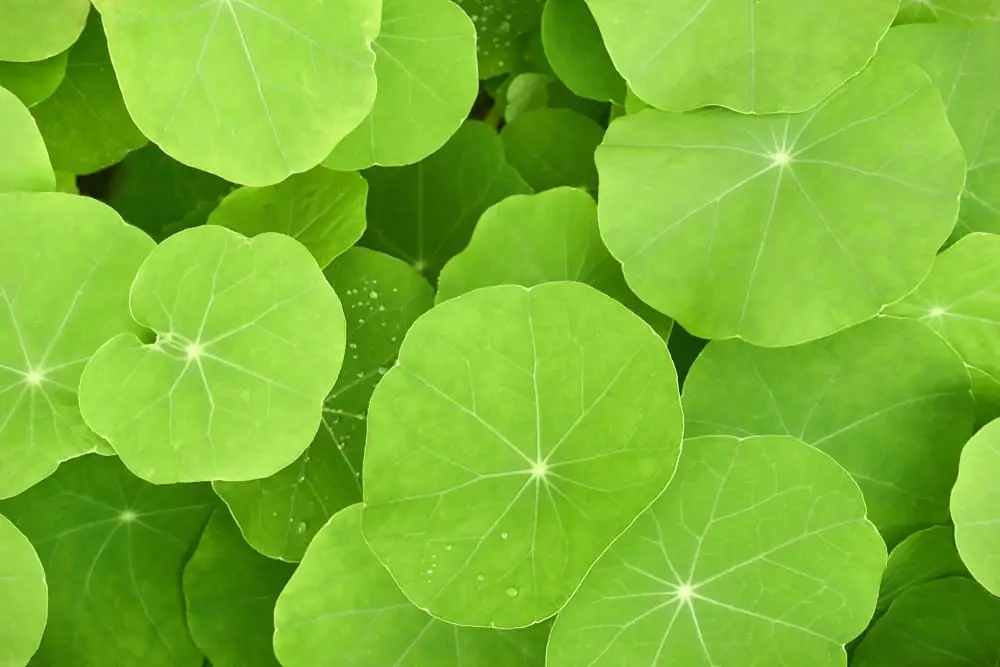
All parts of nasturtium, or Indian cress, are edible. However, it is the leaves that can replace watercress because they share the same pepper-like taste.
The most famous dish of this vegetable is Nasturtium Pesto, and it seems to be never out of date. The nasturtium leaves will bring a fresh peppery and earthy kick into a traditional pesto. Mixed with the sweet roasted nut, this recipe can satisfy even the pickiest eaters.
These leaves contain lots of vitamin C, boosting your immune system to fight off bacteria and viruses. Also, iron found in this green plant can promote the oxygen-carrying process.
If you pick up the leaves in their late-season, they can be rather hard and tough. You can try to blanch them before using them.
4. Endive
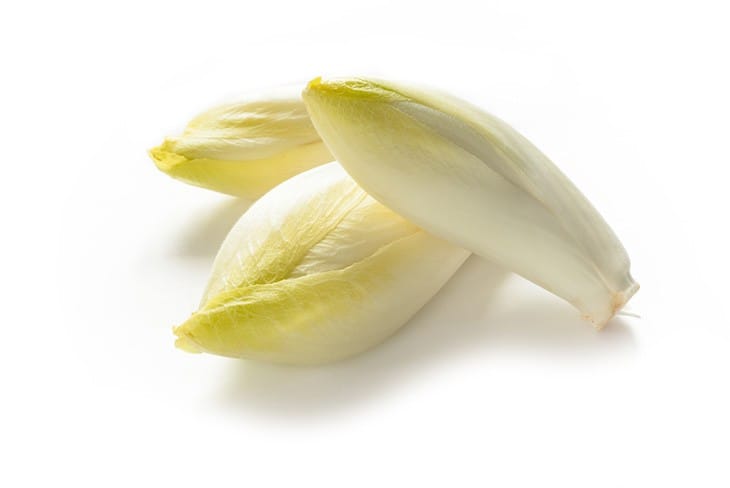
Coming with a tangy and slightly bitter flavor, endive proves itself to be one of the many substitutes for watercress. However, its texture is a bit tougher.
Endive is an ideal choice for roasting, grilling, or braising other than a salad dressing. You can’t miss a Braised Belgian endive dish for the world.
The butter and lime juice make a perfect transition from crisp pungent leaves to luscious and tender bundles. This leafy veggie is a low-calorie food, ideal for weight loss. It’s also prized for boosting heart health, thanks to its potassium and folate components.
Endive is tough, so it would help if you slide it thinly and horizontally.
5. Spinach

Some of you may look for a watercress substitute because you can’t stand its bitter and pungent taste. It is why we include spinach as a suggestion. These leaves are crunchy and slightly sweet.
Spinach’s texture makes it the go-to greens for salads, which can be served to even kids. A simple bowl of fresh spinach and tarragon salad will not require much time but still a great appetizer.
If you can’t put your hand on tarragon vinegar, picking up one from the substitute for tarragon vinegar list can work fine.
Containing a significant amount of vitamin A, spinach can benefit your eye health. Also, vitamin C from this plant acts as an antioxidant to relieve oxidative stress that leads to some types of cancer.
If you prefer cooked spinach, don’t put any water when cooking it. Spinach leaves contain about 90% water, so they will soon get soggy.
6. Water Spinach
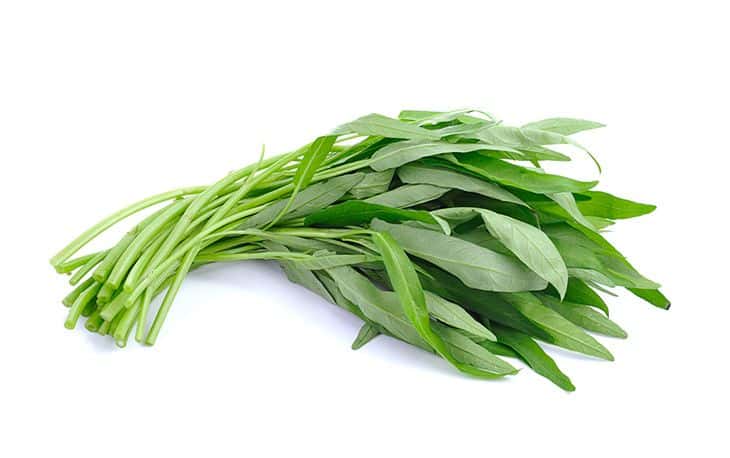
Although this tropical plant doesn’t have a spicy flavor, it does come with long and thin leaves, which can somehow replace watercress.
Water spinach is more tough and crunchy; thus, you can find it in salads, soups, or even well-cooked dishes. You may want to try stir-fried water spinach with garlic and chilies.
This recipe is so simple and quick that anyone can do it at home. The glossy and crispy stems paired with savory and spicy leaves will make you mouth-watering.
Iodine and zinc in water spinach can protect you from dizziness and fatigue as they keep hemoglobin blood stable. Also, water spinach contains lots of vitamin A, which supports your eyes health.
Water spinach stems have white latex. When boiling, it is advisable to add some salt to remain their bright green.
7. Purslane

If you are tired of the peppery bite of watercress, you should give purslane a try. Its succulent stems and leaves bring you a kick out of crispy and lemony flavor.
Containing 93% water, it is best used raw, applicable to sweet and savory dishes like juices, smoothies, sandwiches, and salads. A cup of purslane and blueberry smoothie is an optimal way to beat the summer hit.
Purslane is packed with omega-3 fatty acids, lowering blood pressure and reducing the risk of triglycerides. Vitamin C in this plant also boosts the immune system to handle flu and cold.
Try to use tender purslane in the early season. Although it is succulent, it may be fibrous and woody in the late season.
8. Lettuce

Lettuce does not come with a peppery flavor, but we still put it on this list due to its versatility. This leafy green pops up in most salad plates, so you can always use it as a replacement whenever it calls for watercress.
Apart from salads and sandwiches, lettuce doubles as a pizza topping. But if you are looking for something new, Hoisin meatball lettuce wraps can whet your appetite.
At the first moment you taste it, enjoy the sweet and fresh leaves coming with meaty balls and juicy sauce.
Lettuce is high in fiber and low in calories, making it a good friend for dieters to lower cholesterol. Eating this vegetable regularly also helps you stay away from flu and cold, thanks to the abundant amount of vitamin C.
We recommend tearing lettuce by hand. If you use a knife, remember to use a stainless steel blade. Other kinds will discolor the lettuce and give it a mushy look.
9. Radicchio
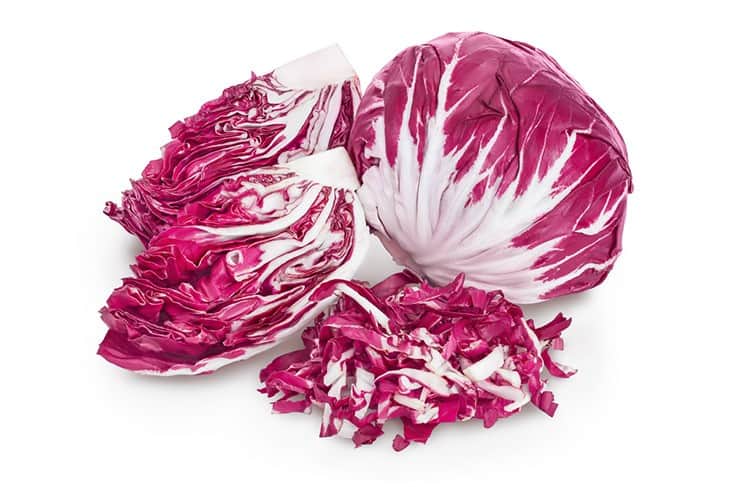
Radicchio is bitter and has a little hint of spice, making it a great alternative for watercress. It’s time to add some new color to your salads with the red radicchio.
You can replace watercress with radicchio in salads, sandwiches, and soups. Not to mention, Roasted balsamic radicchio is not a bad idea for a fresh first course.
The perfect mixture of slightly bitter and spicy radicchio with sweet balsamic will not let you down.
Vitamin K found in radicchio is an essential element to support blood clotting. These leaves also have a great number of antioxidants to ease oxidative stress and enhance your overall energy.
One way to make radicchio sweeter is to cut the head in half, then shred it diagonally.
10. Kale

We recommend kale because of its abundance. You can easily find it at any store, making it a proper choice if you are in a hurry. This plant also gives you a taste profile of bitterness but somewhat stronger than watercress.
Due to its bitterness, some may find it overpowering to make salads. But mixing with other vegetables can tackle the issue.
Besides, Lemony sautéed kale will be a perfect side dish for pasta, pizzas, or frittatas. This side dish will nourish and glorify them with a touch of sourness and bitterness.
Kale is known as a nutritional powerhouse, delivering a ton of vital nutrients. Loaded with antioxidants, kale can improve your energy and mood all day. It is also a huge source of fiber to lower your blood pressure.
Except for making juice, it is better to remove kale stems and ribs when cooking since they are too tough.
11. Dandelion Leaves
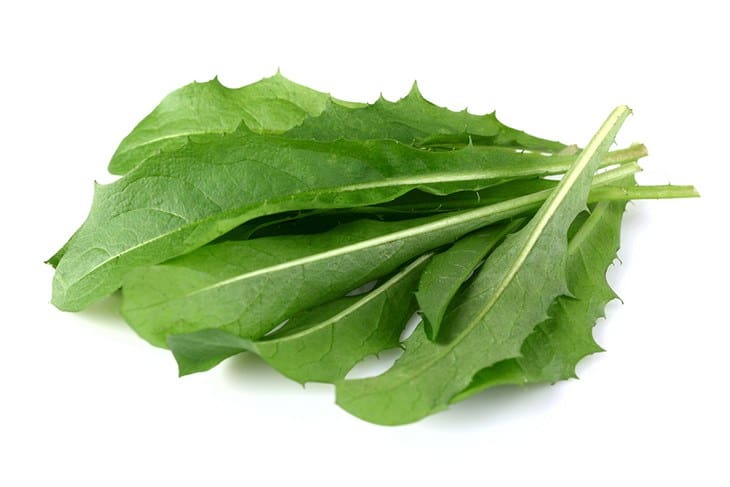
Like kale, the signature of dandelion leaves is their bitter and spicy leaves. Therefore, they can also substitute for watercress.
Having a tougher texture than watercress, dandelion greens can pop up in many recipes, ranging from salads, stir-fries to soups. Besides, a plate of Sautéed dandelion greens with eggs can be a healthy breakfast.
Dandelion greens are highly nutritious, an excellent source of vitamin A and C. These vitamins protect your eyes and your immune system, reducing the risk of flu.
Even better, vitamin E from this plant is a great way to slow down your aging process.
To reduce the bitterness of dandelion greens, you can blanch them with salt from 30 seconds to 2 minutes, depending on their toughness.
12. Cabbage
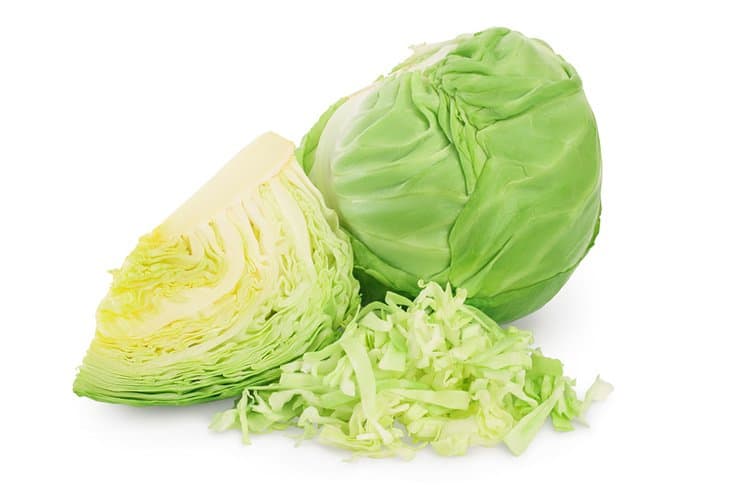
This common vegetable can be your savior when you can’t find anything else to replace the watercress. These sweet leafy greens can go well with any other vegetables.
You are free to use them, either raw or cooked. They can be a salad topping, stir-fried, used in soups, or pizza and sandwich dressing.
Let’s blow a wind of change by trying Keto stuffed cabbage. This dish includes minced pork wrapped with melt-in-the-mouth cabbage and flavorful tomato sauce on top. A wonderful combination of sweetness, acidity, and savory can win anyone’s heart.
Cabbage is high in vitamin C, improving your immune system to protect you from diseases. Consuming cabbage usually can do wonders for your heart health since it is a cruciferous vegetable.
We don’t recommend mixing cabbage with cucumber since this combination will affect the process of absorbing vitamin C.
13. Chinese Cabbage
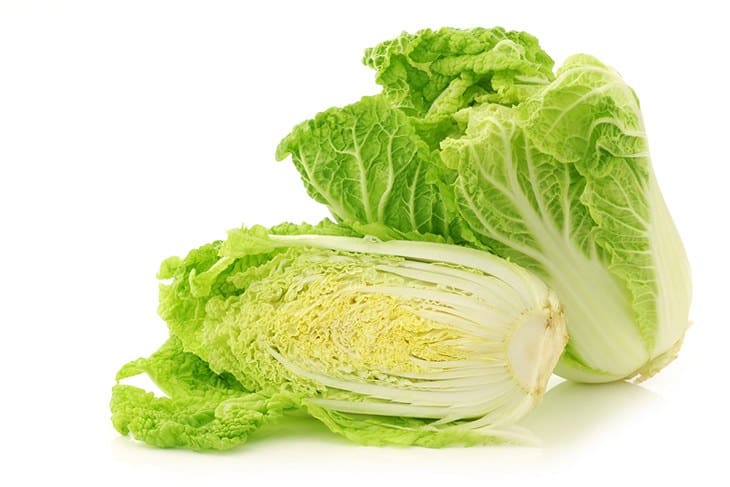
Chinese cabbage shares nearly the same taste as normal cabbages, but it is more tender and succulent. Its crunchy texture enables it to take the place of watercress in some recipes.
You can add Chinese cabbage in salads, sandwiches, or pizzas. But the most common way to cook it is to stir fry. Coming with a little sweet taste, this plant can match any vegetables such as mushroom, tomato, carrot, and more.
These greens are full of vitamin K and C, which benefit your bone health and support the immune system. Even better, Chinese cabbage comes with many antioxidants like carotenes or lutein to boost your energy and get rid of fatigue.
Keep in mind to cook Chinese cabbage at a high temperature and within a short time. If not, it will get soggy and less crispy.
14. Upland Cress
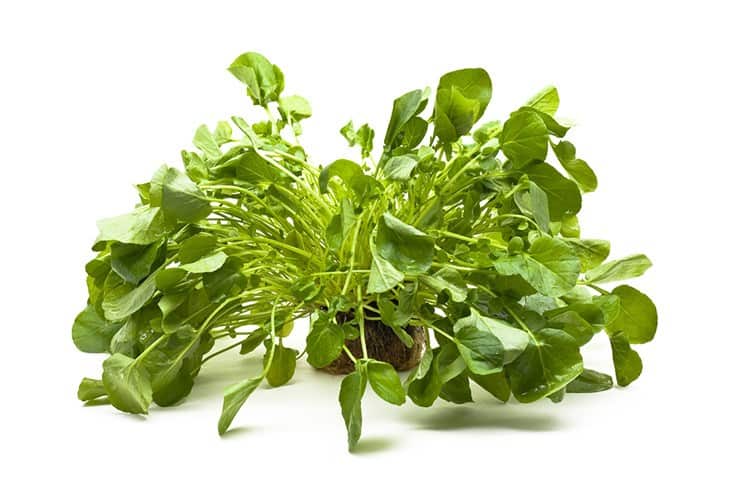
Upland cress, also known as American cress or yellow rocket, has a stronger peppery taste than watercress. Therefore, this kind is also a suitable alternative.
Like watercress, upland cress can appear in salads and sandwiches. However, it is better to consider the tangy flavor. You can also garnish it in soups, cooked meat, or poultry. Its pungency will eliminate the fatty flavor of the meat.
Upland cress contains a great amount of vitamin B2, breaking down fats and proteins and supporting red blood cell production. You can also receive vitamin K to strengthen your bones.
Don’t let the upland cress soak when washing. It will make the leaves mushy and less crunchy.
Frequently Asked Questions
What Is Watercress And Its Taste?
Watercress is an aquatic leafy plant originally from the cabbage family. All parts of it, except the root, are edible.
Raw watercress comes with a peppery taste and a touch of bitter, brightening some appetizers like salads or soups. When cooked, its leaves tend to be less pungent.
How Can We Cook Watercress?
Watercress can be served either raw or cooked.
As I mentioned before, it pops up in many salads and sandwiches. Also, you can add raw watercress as a garnish for soups to enhance their flavor.
Otherwise, if you are too busy but still want something tasty, making a simple plate of stir-fried watercress is not a bad idea.
What Are The Health Benefits Of Watercress?
Being high in nutrients yet low in calories, watercress is the go-to vegetable for weight loss. It is also a good source of vitamin C, boosting your immune system.
Only by consuming one cup of watercress, you gain enough daily value for vitamin K – an essential component to strengthening your bones.
Conclusion
Above are 14 substitutes for watercress, coming with their health benefits and recipes. Selecting a suitable replacement depends on your favorite taste.
As long as that ingredient does not harm you, it is up to you to make a new dish with a little change in the recipe. Time to try and satisfy your passion for cooking.

